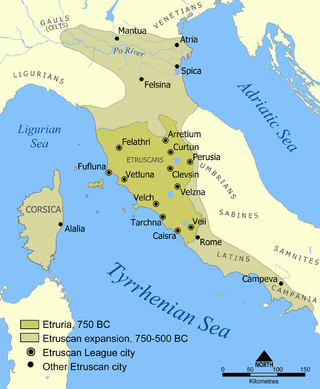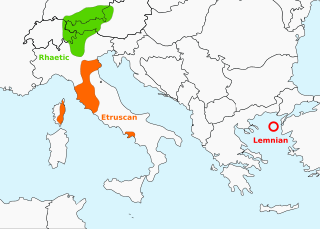
The Etruscan civilization was developed by a people of Etruria in ancient Italy with a common language and culture who formed a federation of city-states. After conquering adjacent lands, its territory covered, at its greatest extent, roughly what is now Tuscany, western Umbria, and northern Lazio, as well as what are now the Po Valley, Emilia-Romagna, south-eastern Lombardy, southern Veneto, and western Campania.

Etruscan religion comprises a set of stories, beliefs, and religious practices of the Etruscan civilization, heavily influenced by the mythology of ancient Greece, and sharing similarities with concurrent Roman mythology and religion. As the Etruscan civilization was gradually assimilated into the Roman Republic from the 4th century BC, the Etruscan religion and mythology were partially incorporated into ancient Roman culture, following the Roman tendency to absorb some of the local gods and customs of conquered lands. The first attestations of an Etruscan religion can be traced back to the Villanovan culture.

Rhaetic or Raetic, also known as Rhaetian, was a language spoken in the ancient region of Rhaetia in the eastern Alps in pre-Roman and Roman times. It is documented by around 280 texts dated from the 5th up until the 1st century BC, which were found through northern Italy, southern Germany, eastern Switzerland, Slovenia and western Austria, in two variants of the Old Italic scripts. Rhaetic is largely accepted as being closely related to Etruscan.

Louis Marie Olivier Duchesne was a French priest, philologist, teacher and a critical historian of Christianity and Roman Catholic liturgy and institutions.

Cerveteri is a town and comune of northern Lazio in the region of the Metropolitan City of Rome. Known by the ancient Romans as Caere, and previously by the Etruscans as Caisra or Cisra, and as Agylla by the Greeks, its modern name derives from Caere Vetus used in the 13th century to distinguish it from Caere Novum.
Mario Torelli was an Italian scholar of Italic archaeology and the culture of the Etruscans. He taught at the University of Perugia.

Tyrsenian, named after the Tyrrhenians, is a proposed extinct family of closely related ancient languages put forward by linguist Helmut Rix (1998), which consists of the Etruscan language of northern, central and south-western Italy, and eastern Corsica (France); the Rhaetic language of the Alps, named after the Rhaetian people; and the Lemnian language of the Aegean Sea. Camunic in northern Lombardy, between Etruscan and Rhaetic, may belong to the family as well, but evidence of such is limited. The Tyrsenian languages are generally considered Pre-Indo-European and Paleo-European.

The Cippus Perusinus is a stone tablet (cippus) discovered on the hill of San Marco, near Perugia, Italy, in 1822. The tablet bears 46 lines of incised Etruscan text, about 130 words. The cippus is assumed to be a text dedicating a legal contract between the Etruscan families of Velthina and Afuna, regarding the sharing or use of a property upon which there was a tomb belonging to the noble Velthinas.

Su Nuraxi is a nuragic archaeological site in Barumini, Sardinia, Italy. Su Nuraxi simply means "The Nuraghe" in Campidanese, the southern variant of the Sardinian language.

Tepe Gawra is an ancient Mesopotamian settlement 15 miles NNE of Mosul in northwest Iraq that was occupied between 5000 and 1500 BC. It is roughly a mile from the site of Nineveh and 2 miles E of the site of Khorsabad. It contains remains from the Halaf period, the Ubaid period, and the Uruk period. Tepe Gawra contains material relating to the Halaf-Ubaid Transitional period c. 5,500–5,000 BC.

Etruscan history is the written record of Etruscan civilization compiled mainly by Greek and Roman authors. Apart from their inscriptions, from which information mainly of a sociological character can be extracted, the Etruscans left no surviving history of their own, nor is there any mention in the Roman authors that any was ever written. Remnants of Etruscan writings are almost exclusively concerned with religion.

Etruscan art was produced by the Etruscan civilization in central Italy between the 10th and 1st centuries BC. From around 750 BC it was heavily influenced by Greek art, which was imported by the Etruscans, but always retained distinct characteristics. Particularly strong in this tradition were figurative sculpture in terracotta, wall-painting and metalworking especially in bronze. Jewellery and engraved gems of high quality were produced.

Narce was a Faliscan settlement in Italy located 5 kilometers south of Falerii. Its residents spoke an Italic language related to Latin. It was inhabited from the 2nd millennium to the 3rd century B.C. The ancient name of the settlement is uncertain, but it may have been called Fescennium.
Visentium was the Latin name of one of the minor Etruscan cities. It was a boundary settlement on the southwestern shore of the Lago di Bolsena and was settled from the Final Bronze Age until the Archaic period.
René Rebuffat was a French historian and archaeologist, specializing in ancient Africa. He conducted archaeological excavations at Thamusida in Morocco, Bu-Njem Gholaia in Libya, and in the Sebou basin in Morocco. He also worked on archaeological sites of Aléria and Jublains.
François Chausson, is a 20th-21st-century French historian, professor of Roman history at the Université Paris 1 Panthéon-Sorbonne.
Yves Modéran was a French historian, a professor of Roman history at the University of Caen Normandy.
Yvon Thébert was a 20th-century French archaeologist and historian of marxist inspiration.
François Jacques was a French historian, a specialist on Ancient Rome. His work focused on municipal life of the Roman Empire and profoundly contributed to a renewal of the historical perspectives on this issue.
Jean MacIntosh Turfa is an American archaeologist and authority on the Etruscan civilization.











